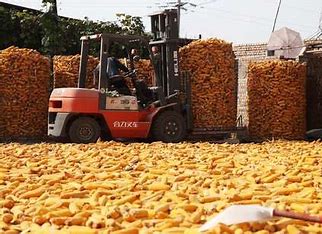Asian country plans to reduce import volume in the next years

12/09/2022
Corn — the second most important agricultural crop in Brazil — has been gaining space in the country. The chain strengthens as companies invest in the genetic improvement of seeds, the cultivated area grows, and markets open up, such as China, which this year issued licenses for imports of Brazilian grain, generating euphoria among farmers. The first cargo, of almost 70,000 tonnes, was shipped in November.
But if on the one hand, the exporters look with an appetite to the Chinese market — there are 1.5 billion people — on the other hand, Beijing’s plans to ensure food security in China are still alive and may frustrate the Brazilians in the long run. The government of Chinese President Xi Jinping wants to rely less and less on food imports.
One of the most recent policies to expand Chinese grain production was launched last year. Named the “revitalization of the seed industry,” it includes partnerships with foreign biotechnology companies, such as the Argentinean Bioceres, approval of transgenics, and governmental contributions to genetic studies.
Brazilians who deal with the international grain market affirm that the Chinese objective is not new. “For at least a decade I’ve been hearing about this intention of China to increase productivity,” says Glauber Silveira, executive director of Abramilho, which gathers producers in Brazil. “But so far they haven’t succeeded,” he adds.
Whether it is the first or the tenth attempt, China knows the size of the challenge — and has set goals to be pursued in this decade. The country wants to raise corn production by about 2% a year, which would result in 324 million tonnes by 2031. With consumption rising by close to 1.5% a year over the same period to 328 million tonnes, the Chinese project to import an average of 7.5 million tonnes of corn in 2031.
The plan is to reduce foreign purchases of corn each year until then. Soybeans and wheat are also the focus of policies to increase productivity. The data is from the Chinese government and was compiled in China Agricultural Outlook 2022-2031, prepared by InvestSP, linked to the São Paulo government, and the Confederation of Agriculture of Brazil (CNA).
“They are highly focused on seeds, seeking to raise productivity by 30% or more. There are important studies involving drought-resistant corn at Sichuan University,” exemplifies José Mario Antunes, COO of InvestSP in Shanghai. Sichuan is a province in the southwest of the country. China has productivity about 40% lower than the United States, for example.
Besides productivity, which is the key issue for Chinese agribusiness, there are other challenges, such as the very implementation of the policies outlined. China does not have a lot of large landholdings like Brazil. It is a much more fragmented, family-based activity, with costs almost all made up of labor and land prices — and there is less use of machinery.
However, the investment in precision agriculture systems, which uses plenty of equipment, is another strategic pillar that has been evolving: “The number of drones used in agriculture has increased 100% per year,” says Mr. Antunes.
China, a traditional corn producer, started to import corn recently, and there was a peak in purchases in the past five years. According to the United States Department of Agriculture (USDA), in the 2017/2018 harvest, the country bought nearly 4 million tonnes of grain from other countries. It has grown ever since, culminating with the 29.5 million tonnes recorded in the 2020/21 cycle. For 2022/23, the U.S. agency projects a lower import, of 18 million tonnes.
The Chinese government’s data is similar: imports in 2021 totaled 28.4 million tonnes, slightly more than double that of 2020. “One reason for this recent increase is the growing demand and the interest in building stocks,” says Francisco Guerreiro Jr., executive director of FJR Consultoria. Besides, there was a change in the swine breeding policy that demanded more raw materials used for the herd ration. According to the summary that brings government data, the food industry consumption grew more than the feed industry.
China likes to keep its grain stocks high. “It’s part of the Chinese obsession,” explained a source close to local negotiators. “They have three obsessions over there: food security, energy security, and technology security,” he added.
The country usually has stocks of corn for 200 days, and wheat for 500 days. Soybean stocks are lower due to a higher turnover, said the source. The plan is to have stocks for six months to a year, and this information is treated almost as a state secret, he continued.
It is because of this need to maintain ample stocks and the accelerated increase in Chinese consumption that Brazilians doubt the reduction of Chinese imports, even in the long term.
Mr. Antunes, with InvestSP, who has already represented Brazilian Animal Protein Association (ABPA) in China, highlights that it is important not to underestimate the capacity of the Chinese to make “fast changes.” “The country’s pig herd was decimated in 2018 by African swine fever. At the time we thought recovery would take four or five years, but after just two [years], the stock was already re-established,” he recalls.
*By Erica Polo — São Paulo
